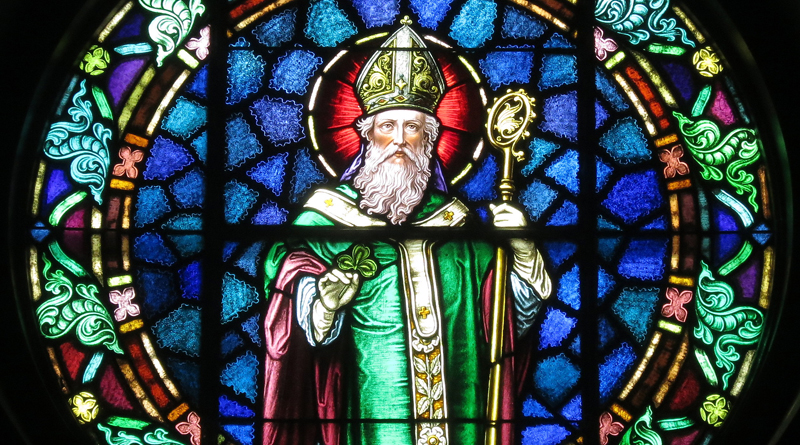St. Patrick Was A Saint, I Ain’t

The “wearing of the green” on March 17 in honor of St. Patrick, along with all the parades with their bagpipes and blarney, is part of a folk ritual that announces the death of winter and the birth of spring. On this day, Irish and Irish-Wanna-Be’s all toast the patron saint of Ireland with all things green, especially beer!
No other saint’s feast day is so associated with play and make-believe as leprechauns dance on your roof. Pubs overflow and parades defy bad weather as friends party and good times abound.
But, seriously, did you ever look into who St. Patrick really was? Legends about him are numerous but details of his life are uncertain. Perhaps he was not the fun-and-games saint we make him out to be or even a canonized saint for that matter.
The date and place of Patrick’s birth are uncertain and are said to be either in Dunbarton, Scotland, or Cumberland, England. Born sometime between the years 385 and 389, he was the son of Calpurnius and Conchessa. At about age 16, Patrick and many of his father’s slaves and vassals were captured by Irish raiders and sold as slaves in Ireland, obliged to serve a heathen master as herdsmen. Although many believe he was taken to live in Mount Slemish in County Antrim, it is more likely that he was held in County Mayo near Killala. Lonely, hungry, cold, and afraid, he turned to his religion for solace, becoming a devout Christian.
After six years, Patrick escaped from captivity, probably to France, and later to Britain at the age of 22. Patrick began religious training, a course of study that lasted more than 15 years. He may have studied at Lerins, off the French coast; he spent 15 years at Auxerre. After his ordination as a priest, he was sent to Ireland with a dual mission: to minister to Christians already living in Ireland and to begin to convert the Irish. (Interestingly, this mission contradicts the widely held notion that Patrick introduced Christianity to Ireland.) He was consecrated bishop at the age of 43.
Because of the island’s pagan background, Patrick was emphatic in encouraging widows to remain chaste and young women to consecrate their virginity to Christ. He ordained many priests, divided the country into dioceses, held Church councils, founded several monasteries, and continually urged the people to greater holiness in Christ.
He suffered much opposition from pagan druids and was criticized in both England and Ireland for the way he conducted his mission. But, in a relatively short time, the island had deeply experienced the Christian spirit, and was prepared to send missionaries whose efforts were greatly responsible for Christianizing Europe.
Patrick was a man of action, with reportedly little inclination toward learning. He had a rocklike belief in his vocation, in the cause he had espoused. Familiar with the Irish language and culture, Patrick chose to incorporate traditional ritual into his lessons of Christianity instead of attempting to eradicate native Irish beliefs. For instance, he used bonfires to celebrate Easter since the Irish were used to honoring their gods with fire. He also superimposed a sun, a powerful Irish symbol, onto the Christian cross to create what is now called a Celtic cross, so that veneration of the symbol would seem more natural to the Irish.
Toward the end of his life, he retired to Saul, where he may have written his Confession, his most famous writing, that tells the brief story of his life, told through his own eyes. The work is more theological in nature than autobiographical. By the time of his death on March 17, 461, he had established monasteries, churches, and schools. Ireland came to celebrate his day with religious services and feasts. And there is hope, rather than irony, that his burial place is said to be in strife-torn Ulster, in County Down.
Many legends grew up around him — for example, that he drove the snakes out of Ireland and used the shamrock to explain the Trinity. However, about three million years ago, the Ice Age arrived, meaning that snakes, being cold-blooded creatures, were no longer able to survive, so Ireland’s snakes vanished. Patrick reportedly used a shamrock to visualize the mystery of the Trinity, how a single plant with three leaves is analogous to the one Triune God with three separate and distinct Persons.
What distinguishes Patrick is the durability of his efforts. When one considers the state of Ireland when he began his mission work, the vast extent of his labors (many parts of Ireland) and how the seeds he planted continued to grow and flourish, one can only admire the kind of man Patrick must have been.
Ironically, there was no formal process for canonization in place when Patrick died. He was proclaimed a saint by popular acclaim, probably with the approval of a bishop. The official process for canonization did not come until about the 12th century.
- A July 4th Mystery Or Strange Coincidence? - July 5, 2024
- What Is Flag Day All About? - June 7, 2024
- ‘Mayday!’ & May Day - May 10, 2024


